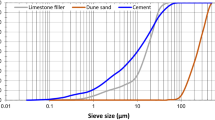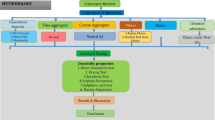Abstract
The main consequence of Alkali-Silica Reaction is the formation of cracks due to expansion, which can lead to a reduction in resistance capacity of the section of the structural element. The addition of steel fibers (micro fibers and Macro fibers) in the concrete, leads to considerable changes in the material properties in terms of its mechanical and durability performance, even under operating loads. This involves reducing or eliminating the formation of cracks, thus limiting the penetration of corrosive agents. In order to understand the behavior of steel fibers on concrete subjected to ASR due to the presence of highly reactive coarse aggregate (Sudbury aggregate), a 4-month accelerated laboratory testing campaign was conducted with four mix designs (plain concrete, 0.5% Macro fiber, 1.0% Macro fiber, 1.0% Hybrid: 0.5% Macro and 0.5% micro fiber). To speed up the ASR reaction process the samples were exposed to 50 °C temperature and 100% R.H. in a moisture chamber for the entire maturation period. Prisms, cubes, cylinders and beams were cast and tested for: longitudinal expansion, dynamic elastic modulus, damage rating index, compressive strength, static modulus of elasticity and flexural tensile strength. The main result was that the 1.0% Macro mix design is the one that most mitigates the formation of cracks.
Access this chapter
Tax calculation will be finalised at checkout
Purchases are for personal use only
Similar content being viewed by others
References
Rajabipour, F., Giannini, E., Dunant, C., Ideker, J.H., Thomas, M.D.A.: Alkali–silica reaction: current understanding of the reaction mechanisms and the knowledge gaps. Cem. Concr. Res. 76, 130–146 (2015)
Turanli, L., Shomglin, K., Ostertag, C., Monteiro, P.J.: Reduction in alkali–silica expansion due to steel microfibers. Cem. Concr. Res. 31(5), 825–827 (2001)
Yazɩcɩ, H.: The effect of steel micro-fibers on ASR expansion and mechanical properties of mortars. Constr. Build. Mater. 30, 607–615 (2012)
Tiberti, G., Minelli, F., Plizzari, G.: Crack control in fibrous RC elements. In: Proceedings of the 8th RILEM International Symposium on Fibre Reinforced Concrete: Challenges and Opportunities (BEFIB 2012), pp. 187–188 (2012)
Vasanelli, E., Micelli, F., Aiello, M., Plizzari, G.: Long term behaviour of fiber reinforced concrete beams in bending. In: Proceedings of the 8th RILEM International Symposium on Fibre Reinforced Concrete: Challenges and Opportunities (BEFIB 2012), pp. 161–162 (2012)
Paulík, P., Hudoba, I.: The influence of the amount of fibre reinforcement of high performance concrete. Slovak J. Civ. Eng. 2, 1–7 (2009)
Giaccio, G., Bossio, M.E., Torrijos, M.C., Zerbino, R.: Contribution of fiber reinforcement in concrete affected by alkali-silica reaction. Cem. Concr. Res. 67, 310–317 (2015)
Panesar, D.K., Gautam, B.P.: Triaxial expansion of plain, reinforced and fiber-reinforced ASR affected concrete. In: Proceedings of the International Conference on Structural Mechanics in Reactor Technology (SMiRT-24 BEXCO) (2017)
C. A23.1-14/A23.2-14: Concrete Materials and Methods of Concrete Construction/Test Methods and Standard Practices for Concrete. CSA Group (2014)
Gautam, B.P., Panesar, D.K.: Microscopic cracking of ASR-affected fiber-reinforced concrete. In: ACI the Concrete Convention and Exposition (2017)
Bektaş, F., Turanli, L., Ostertag, C.P.: New approach in mitigating damage caused by alkali–silica reaction. J. Mater. Sci. 41(17), 5760–5763 (2006)
Barborak, R.: Fiber reinforced concrete (FRC) DMS-4550 tip sheet. In: Construction and Materials Tips (2011), p. 4
Gautam, B.P., Panesar, D.K., Sheikh, S.A., Vecchio, F.J.: Effect of coarse aggregate grading on the ASR expansion and damage of concrete. Cem. Concr. Res. 95, 75–83 (2017)
Gautam, B.P., Panesar, D.K.: The effect of elevated conditioning temperature on the ASR expansion, cracking and properties of reactive Spratt aggregate concrete. Constr. Build. Mater. 140, 310–320 (2017)
ASTM C1293: Standard Test Method for Determination of Length Change of Concrete Due to Alkali-Silica Reaction. ASTM International, West Conshohocken (2018)
ASTM C1064: Standard Test Method for Temperature of Freshly Mixed Hydraulic-Cement Concrete. ASTM International, West Conshohocken (2017)
ASTM C143: “Standard Test Method for Slump of Hydraulic-Cement Concrete. ASTM International, West Conshohocken (2015)
ASTM C138: Standard Test Method for Density (Unit Weight), Yield and Air Content (Gravimetric) of Concrete. ASTM International, West Conshohocken (2017)
ASTM C231: Standard Test Method for Air Content of Freshly Mixed Concrete by the Pressure Method. ASTM International, West Conshohocken (2017)
ASTM C127: Standard Test Method for Relative Density (Specific Gravity) and Absorption of Coarse Aggregate. ASTM International, West Conshohocken (2015)
ASTM C128: Standard Test Method for Relative Density (Specific Gravity) and Absorption of Fine Aggregate. ASTM International, West Conshohocken (2015)
ASTM C566: Standard Test Method for Total Evaporable Moisture Content of Aggregate by Drying. ASTM International, West Conshohocken (2014)
ASTM C192: Standard Practice for Making and Curing Concrete Test Specimens in the Laboratory. ASTM International, West Conshohocken (2016)
EN 14651: Test Method for Metallic Fibre Concrete – Measuring the Flexural Tensile Strength (Limit of Proportionality (LOP), Residual). European Standard (2007)
ASTM C215: Standard Test Method for Fundamental Transverse, Longitudinal, and Torsional Resonant Frequencies of Concrete Specimens. ASTM International, West Conshohocken (2014)
Villeneuve, V., Fournier, B., Duchesne, J.: Determination of the damage in concrete affected by ASR the damage rating index (DRI). In: Proceedings of the 14th International Conference on Alkali-Aggregate Reaction Concrete, p. 10 (2012)
ASTM C1556: Standard Test Method for Determining the Apparent Chloride Diffusion Coefficient of Cementitious Mixtures by Bulk Diffusion. ASTM International, West Conshohocken (2011)
ASTM C39: Standard Test Method for Compressive Strength of Cylindrical Concrete Specimens. ASTM International, West Conshohocken (2018)
Ramlochan, T., Thomas, M., Gruber, K.A.: The effect of metakaolin on alkali–silica reaction in concrete. Cem. Concr. Res. 30(3), 339–344 (2000)
ASTM C469: Standard Test Method for Static Modulus of Elasticity and Poisson’s Ratio of Concrete in Compression. ASTM International, West Conshohocken (2014)
Swamy, R.N.: Cement Replacement Materials. Surrey University Press, Glasgow (1986)
Acknowledgments
The authors acknowledge the support from the Ministry of Transportation Ontario (MTO), Canada for providing the highly reactive coarse Sudbury aggregates and CBM Aggregate for providing the non-reactive fine aggregates. The authors also acknowledge the staff of the University of Toronto Structural Testing Facility and Concrete Materials Laboratories for technical support throughout experimental work.
Author information
Authors and Affiliations
Corresponding author
Editor information
Editors and Affiliations
Rights and permissions
Copyright information
© 2022 RILEM
About this paper
Cite this paper
Mantelli, S.G., Panesar, D.K., Minelli, F. (2022). Influence of Steel Fibers on Damage Induced by Alkali-Silica Reaction of Concrete with Reactive Sudbury Aggregates. In: Serna, P., Llano-Torre, A., Martí-Vargas, J.R., Navarro-Gregori, J. (eds) Fibre Reinforced Concrete: Improvements and Innovations II. BEFIB 2021. RILEM Bookseries, vol 36. Springer, Cham. https://doi.org/10.1007/978-3-030-83719-8_4
Download citation
DOI: https://doi.org/10.1007/978-3-030-83719-8_4
Published:
Publisher Name: Springer, Cham
Print ISBN: 978-3-030-83718-1
Online ISBN: 978-3-030-83719-8
eBook Packages: EngineeringEngineering (R0)




